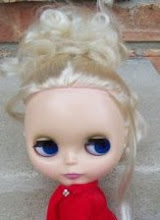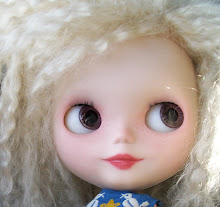

I've blogged before about how much I enjoy finding vintage Skipper and Francie outfits again, that I once had in childhood, for my Blythes to wear, like Gwyneth above in "Town Togs" from 1965. Experts and amateurs all seem to disagree on the proper number of years which define an antique or qualify something as vintage. Collectors and appraisers even disagree among themselves. And Google is little help; it depends on whether one is talking about furniture, cars, glassware, etc.
If the star of author Jennie D’Amato’s book is vintage, then I’m perilously close. However, D’Amato’s subject looks great for her age and doesn’t seem a bit shook up about being 50. Even Time columnist Nancy Gibbs referenced the first anniversary of her 49th birthday in a recent column.
Only Barbie has it easy. Turning 50 recently was the source of much hoopla, and cause for a coffee table book, a beautiful hardcover: Barbie All Dolled Up, Celebrating 50 Years of Barbie, (2009, Running Press Book Publishers, 128 pp., $29.95). I was interested in the book, not just because I collect dolls and doll clothes but mostly because I grew up with Barbie & Friends, as Mattel called “them”: the tall, skinny, tanned, extremely gorgeous girls and guys with fabulous wardrobes, no responsibilities, no homework, no parents, and no worries.
If all that sounds silly, I don’t worry. I know I am not alone in personifying Barbie, Ken, Midge, Alan, PJ, Stacey, Skipper, Scooter, Francie, Casey and their ilk. I know my friends did, too, and it’s verified by the great quotes and stories in this book. Even Barbie’s creator, Ruth Handler, made her from a living, breathing model, daughter Barbara. Ruth’s husband was one of the two co-founders of Mattel, Inc., and the couple and his partner debuted Barbie in 1959.
For those who don’t know it, the history is fun to read in the book. For those who do, seeing that parade of dolls and fashions again from one’s childhood is well worth the price of the book. In fact, that was the main attraction to me—having recently started collecting Skipper and Francie fashions from the early 1960s, I wanted a visual reference—to sort the originals or vintage from the reproductions. This becomes extremely important, not only because Mattel has re-issued many of its classic Barbie fashions but also because so many of the outfits, happily played with by children all over the world, have been scarce to find still MIP (mint, in package) that collectors resort to acquiring the outfits piece by piece, shoe by tiny shoe on on-line auctions, at garage sales, flea markets and more. Knowing whether a white or black plastic flat skimmer shoe (or “flat”) was supposed to go with an outfit called “Tea Time” is helpful, and knowing whether the shoe was supposed to be marked “Japan” or some other designation is, too.
Unfortunately, the book does not have one comprehensive photo or list, but is it a full-color compendium of the best of the best, from the first issues in 1959 of an all-business, imperious looking Barbie (I can’t believe I used to think she looked liked a fun playmate; she looks like a mean boss!) to those over-the-top Bob Mackie ball gowns of the excessive 1980s and on to the famous designers of today who have created an outfit or lent their names for Barbie: Versace, Kate Spade, Anna Sui, Todd Oldham, Juice Couture, Dooney and Bourke and of course, Disney, Hello Kitty, Warner Brothers, Harley Davidson, Hard Rock Café and many more.
Another fun and innovative feature of this book, perhaps especially for us who “lived it once” already, is the many pull-out, fold-out and/or removable souvenirs inside, like the Barbie fan club card and newsletter, reproduction package inserts and even not one, but three frame-worthy prints of sketches by famed Barbie designer Robert Best. Those also make the book a collector’s edition that is well worth its price.
You can debate all you want whether age 50 makes Barbie an antique, but it would be hard to disagree that she’s collectible. Just take a look at the many on-line auction sites with Barbie items, the numerous fan clubs around the world, collectors’ conventions, museum exhibits (The Indianapolis Children’s Museum has Barbie: The Fashion Experience through February 2011) and more. Unopened fashions from the 1960’s are selling in some cases for hundreds if not thousands of dollars.
I’m too much of a bargain-hunter and novice collector for that, but I do take special pleasure in buying and handling (again) the outfits I remember so well from my childhood. Although I choose to use these fashions in my Blythe hobby now, they produce vivid, living color memories even though those memories are, ahem, nearly 50 years old. You don’t have to be a Barbie collector to enjoy this book. If you collect dolls of any sort or simply appreciate or follow pop culture, the 1960s-1970s, fashion, graphic design, even business and marketing, you’ll appreciate this resource.














































No comments:
Post a Comment